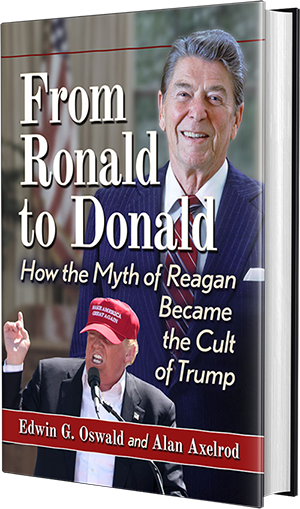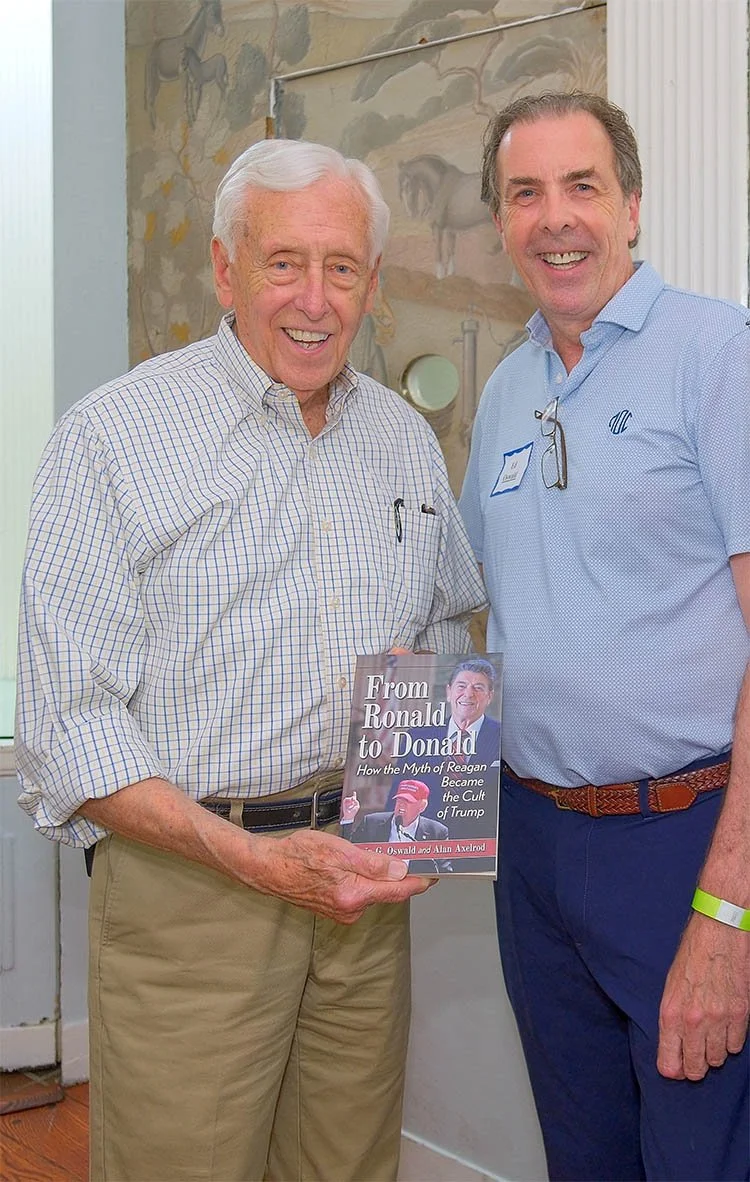From Ronald to Donald
How the Myth of Reagan Became the Cult of Trump
Available in All Formats
On March 16, 2016, the cover of Time featured an over-the-shoulder photograph of Ronald and Nancy Reagan surveying the throng at the GOP convention that nominated him in 1980. “What happened to this party?” the headline asks.
And, ever since, bewildered, demoralized, and, yes, frightened Americans have been asking this question—or a variation on it: “How could the Party of Reagan have become the Party of Trump?”
There is an answer, and it is in this book.
It was inevitable.
The Party of Trump is the reincarnation of the Party of Reagan, who ran in 1980 under the original MAGA banner: “Let’s Make America Great Again.” As a February 22 Washington Post perspective piece put it, “Purging Trumpism from the party will require a reckoning with how the 40th president paved the way for the norm-shattering 45th president.” Now, we are not saying that a resurrected Reagan would recognize himself in Donald Trump or even discern any common cause with him. And yet the election of Donald Trump – in many ways we explore in this book – is an unintended consequence of the single most famous political pronouncement made by the 40th: “Government is not the solution to our problem. Government is the problem.”
The book examines Reagan’s life and the power of the Reagan myth that still burns brightly in the American psyche. The book neither praises nor buries Reagan – but attempts to explain him in objective non-partisan terms of contemporary mythology. There is Reagan as tax cutter, deficit hawk, promoter of deregulation, the ordinary citizen, champion of traditional family values, small government and free market capitalism – all indelible images.
By understanding the transformative presidency of Ronald Reagan in the context of American history and of the American presidency, we can understand how a transformative president creates far more than policy by also shaping culture with the instrumental force of mythology.
For the Reagan “myth” is actually the most salient “fact” of his very momentous presidency, even as very different mythologies were at the core of the presidencies of FDR, Eisenhower, and Kennedy. For that matter, practically all that we generally remember of Theodore Roosevelt, Lincoln, and George Washington himself are the mythologies surrounding them.
On a cold morning on January 20, 1981, Reagan in his first inauguration speech, spoke the following words - “In this present crisis, government is not the solution to our problem; government is the problem.” Over the years, for many of the GOP faithful, all that is remembered is “Government is not the solution to our problem; government is the problem.”
The omission of these four words is a trivial thing, a little thing. Yet from trivial and little things very big things may get their start. A presidency, for example, enshrined in myth. As Ronald Reagan delivered this sentence, it was a diagnosis of a present crisis. These words are time sensitive. They do not speak of eternity but of an immediacy that implies a temporary situation. Attached to the independent clause that follows, the four words limit it severely. Government is “not the solution”—in this present crisis. Government “is the problem”—in this present crisis. Thus stated, it is not an oracular pronouncement, but a diagnosis of a temporary economic “affliction.”
Take away the limiting clause, crumple it up, and forget about it. Do this, and you have created a pronouncement of mythic proportion. Government is not the solution to our problem; government is the problem. It is no longer an issue of the present crisis. Government is bad. Period. This is the Gospel, the New Testament, and, politically speaking, its recollection, minus the first four words, cast Ronald Reagan in his greatest role ever, the conservative Messiah.
This was the founding myth of Reagan’s reformation of America. It was a negative myth, which attempted to sweep aside the model of government that his early political hero, Franklin Roosevelt, had raised to mythic proportions himself: government that was the solution.
Trump’s version of “government is the problem” was “Drain the Swamp”. The truth is that, in electing Donald Trump, Americans did not ask for a leader who was competent and informed. What they got was the very leader they voted for, the one who disavowed government, free trade, science, climate change, objective facts, and expertise alike, proclaiming in messianic fashion at the GOP convention, “I alone can fix it.”
Why I Wrote From Ronald to Donald
I’m a tax lawyer by trade and currently a partner at a law firm in Washington DC. I also served in the second term of the Clinton Administration as the attorney-advisor for tax-exempt bonds in the US Treasury’s Office of Chief Legislative Counsel, where I worked on tax policy matters impacting US public infrastructure. My range of responsibilities included regulatory matters and coordination with IRS and SEC on certain enforcement actions. I worked regularly on tax legislation with White House staff and economists, House Ways & Means Committee, and the Senate Financing Committee staff.
Professionally, my interest in Ronald Reagan is filtered through tax policy and the strategic misconceptions of tax policy that are inextricably bound up with the myths of Reagan and Reaganomics.
Personally, however, my interest runs deeper.
My father was a minor league catcher for the Philadelphia Phillies and passed away at the age of forty when I was seven. My two brothers at that time were one and three, so that, in an instant, I became the man of the house. My mother, a registered nurse, never remarried. Being raised by a single mother, we faced our share of financial challenges.
As a young man, I held a wide range of jobs, starting with a paper route when I was twelve. That led to mowing lawns, washing dishes in a restaurant, scooping soft-serve at a Carvel ice cream store, and pumping gas—years of that. Money to pursue a college education and perhaps beyond was scarce until my big break. It came in the form of a union job at JFK International Airport. It provided the resources to finance an education and advance my life. It was also how I “met” Ronald Reagan.
Other than Franklin Delano Roosevelt, Ronald Wilson Reagan was the most consequential president of the last century. The two men were the matter and antimatter of American political-social policy. Where FDR offered the people a New Deal, with the federal government serving as the engine that moved the nation forward, Reagan dismissed government as “the problem.”
Ed Oswald & Steny Hoyer, a member of the House who has served as the representative of Maryland's 5th congressional district since 1981.
Ronald Reagan’s big break would come in November 1980. Mine came earlier that year, in June, when the catering department of British Airways at JFK hired me as a “Port Steward.” My job was to drive a large truck to the airport kitchen, load it with food, drive up to a 747 at the gate, operate a hydraulic scissors lift to raise the cargo compartment three stories to the aircraft’s galley door, and onload meals for more than 400 London-bound passengers and crew. On time, every time, and with very little time.
As a Port Steward and later as a Passenger Service Agent, I was a member of the Machinists Union. As an airline employee, I parked daily in the employee lot and hopped on the yellow school bus that wound its way through the JFK byways to drop workers off at the various terminals. In August 1981, eight months into President Reagan’s first term, as the bus worked its way around the airport, I gazed at the picket line of striking air-traffic controllers who belonged to the PATCO union. Those of us on the bus were overwhelmingly union members and felt solidarity with the strikers. Citing primarily safety concerns, they had walked out in violation of federal labor law, which prohibited them from striking. They had reason to believe that President Reagan would be sympathetic because Candidate Reagan had been supportive of the workers and their union. PATCO reciprocated with an endorsement. But instead of sympathy, the PATCO traffic controllers received an ultimatum: return to work or get fired.
Most of them were fired. Back then, many air-traffic controllers were ex-military, patriots now banned from future federal employment. The firing sent a shockwave through the union membership at JFK and beyond. There was among us, the union rank and file, a collective sense that the ground has shifted beneath our feet. Under Reagan, unions would have far less power, union workers would be replaced by cheaper part-time non-union labor. Wages and benefits would shrink .
During this time, one evening, a British Air coworker and twenty-year-plus union member asked me if I still was attending college, St. John’s University in New York.
“Yes,” I said, a little sheepishly.
“Good. Be sure you graduate —because the days of making a living wage for a middle-class lifestyle as a union employee are numbered. We know that now.”
I remember that conversation to this day. I told him that I planned to take the CPA exam after college graduation and then go to law school. He assured me that I would need that type of education to survive in the changing American landscape. I took his advice to heart because I was beginning to understand what it meant to be living in Reagan’s America. Some forty years later, we are still living in Reagan’s America, or rather, in the mythic paradigm of the America he, his presidency, and his party created. I wrote this book so that I could understand that paradigm and share my understanding with others, who now find themselves struggling in a product of that mythology called Trump’s America.

